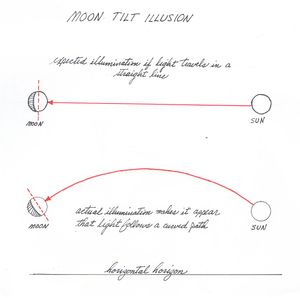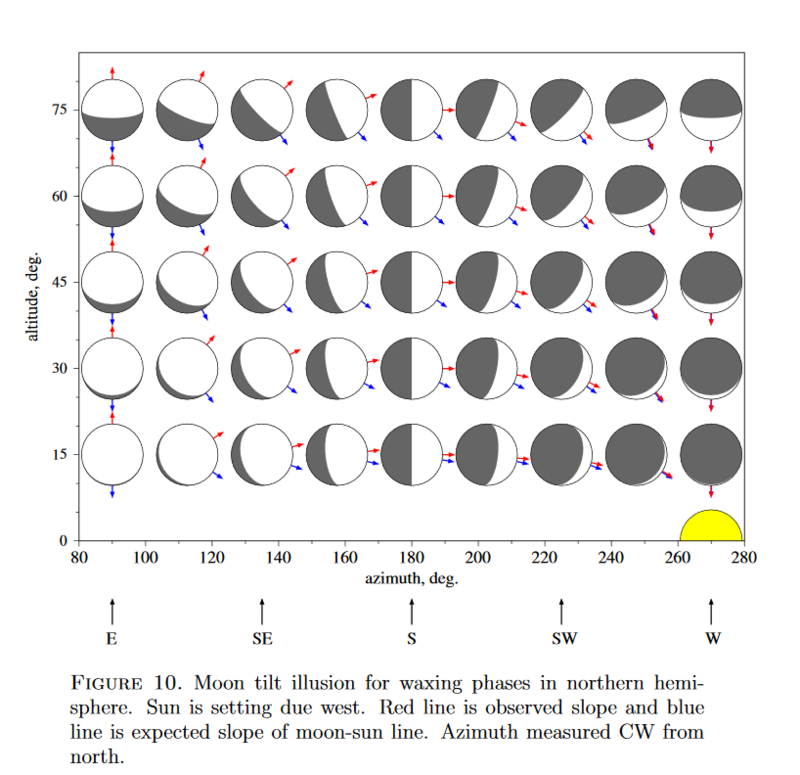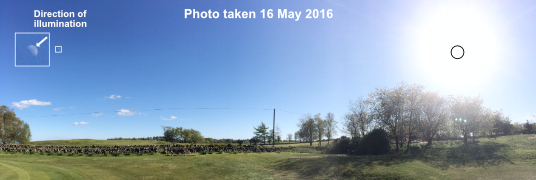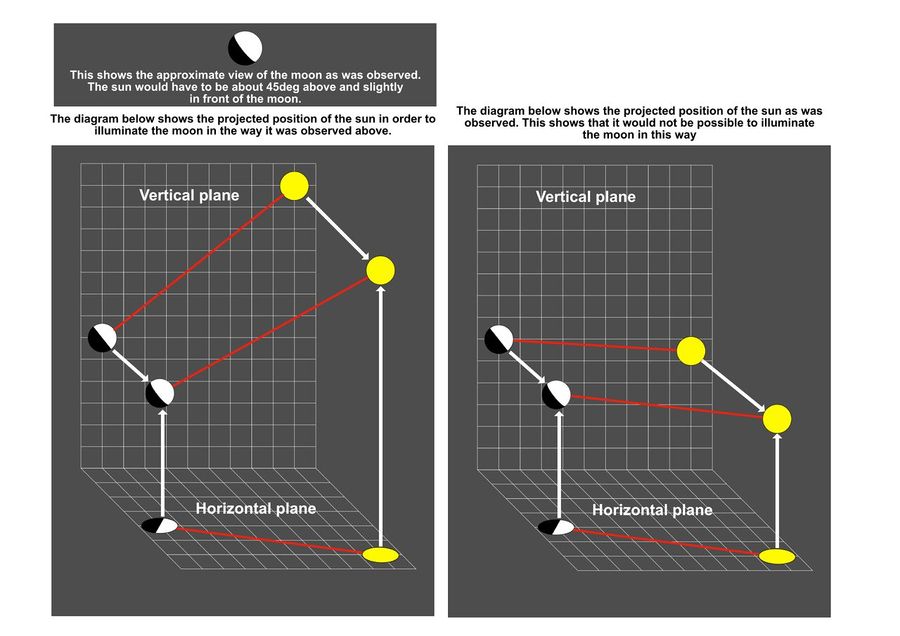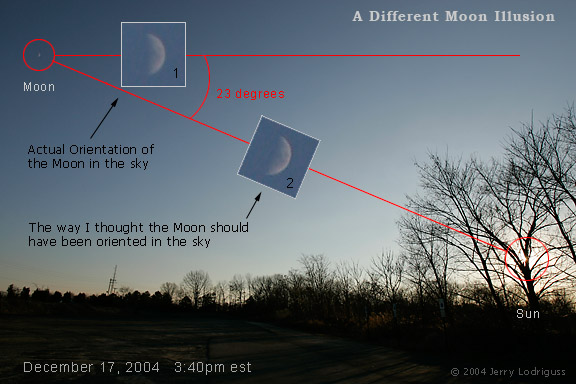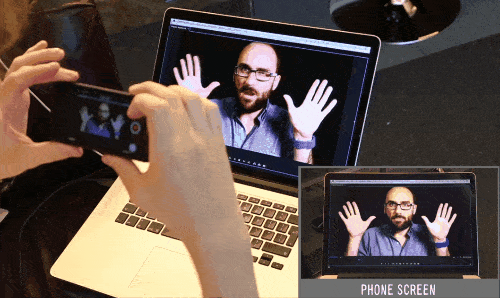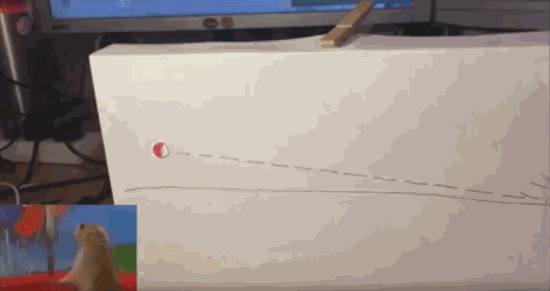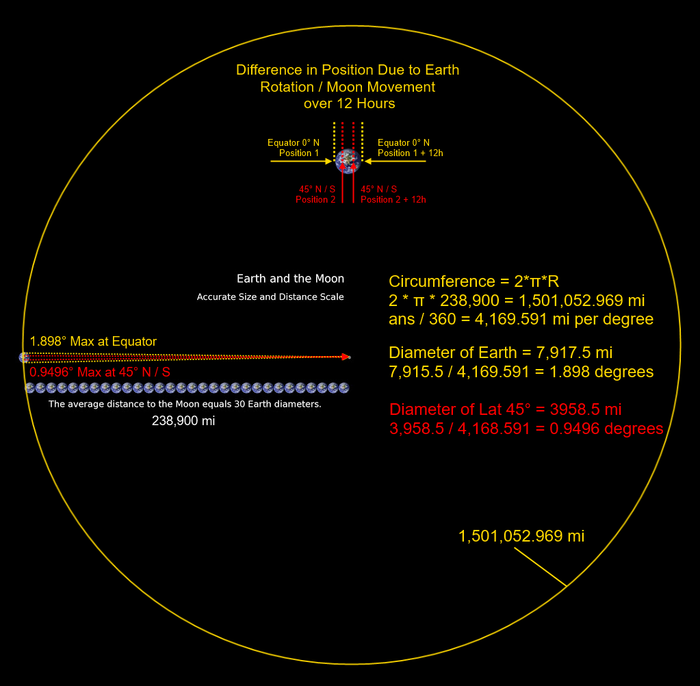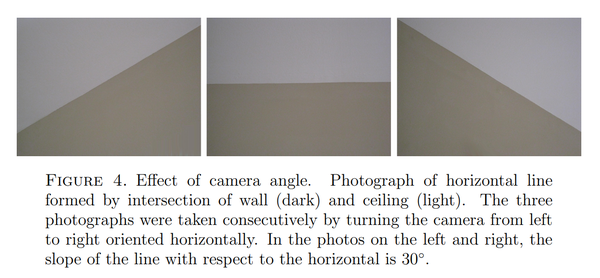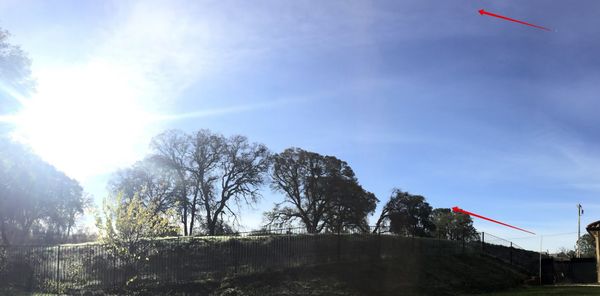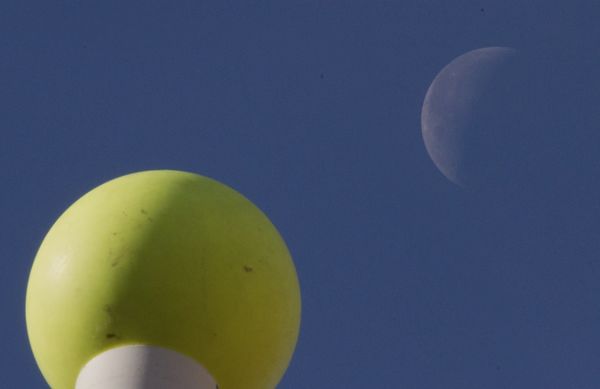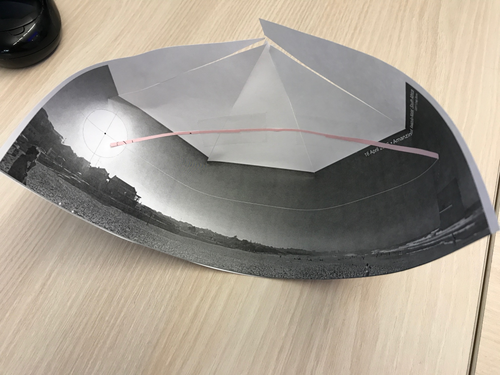Difference between revisions of "Moon Tilt Illusion"
Tom Bishop (talk | contribs) |
Tom Bishop (talk | contribs) |
||
| Line 193: | Line 193: | ||
Hence, the concept of a celestial sphere is seen to be a contrived concept bearing no relation to the 3D space which the Sun-Earth-Moon systems of astronomy are said to exist in. As there is no sphere around the Earth in RET upon which straight lines may become curved, it is again found that a geometric explanation for the Moon Tilt Illusion is unavailable. Astronomers disagree among themselves on the cause, with some speculating on a planetarium-like celestial sphere which does not exist in the physical Sun-Earth-Moon system. | Hence, the concept of a celestial sphere is seen to be a contrived concept bearing no relation to the 3D space which the Sun-Earth-Moon systems of astronomy are said to exist in. As there is no sphere around the Earth in RET upon which straight lines may become curved, it is again found that a geometric explanation for the Moon Tilt Illusion is unavailable. Astronomers disagree among themselves on the cause, with some speculating on a planetarium-like celestial sphere which does not exist in the physical Sun-Earth-Moon system. | ||
| − | ==Celestial Sphere Project== | + | ===Celestial Sphere Project=== |
We are given a Moon Tilt Illusion scene cut into a 'Celestial Sphere' to give a better idea on "how things work in 3D space." Straight lines become curved on the celestial sphere. | We are given a Moon Tilt Illusion scene cut into a 'Celestial Sphere' to give a better idea on "how things work in 3D space." Straight lines become curved on the celestial sphere. | ||
Revision as of 18:31, 20 August 2019
The Moon Tilt Illusion is a phenomenon in which the lit portion of the Moon is sometimes seen to point away from the Sun, the phenomenon being most noticeable and extreme for phases between Half Moon and Full Moon and between Moonrise and the Moon's Zenith. The Moon Tilt Illusion even occurs after the Sun has set below the horizon, with the Moon pointing upwards and away from the Earth.
The cause for this is often attributed to 'perspective'. However, this explanation exists without geometric models which explain how this can occur in the Sun-Earth-Moon system of astronomy. References to close range perspective effects are made, where angles seem to change and warp, but a geometric explanation for the Round Earth system with distant bodies which remain the same distance from the observer at all times is unavailable. Some speculate on a 'celestial sphere' which the celestial bodies glide upon, and upon which straight lines become curved. The explanations is, in contrast, incompatible with the Sun-Earth-Moon system of astronomy in 3D space -- there is not a sphere above the earth which light travels along to become curved.
The phenomenon of the Moon Tilt Illusion is unable to be modeled or described with the systems proposed by modern astronomy. If the system is true, then the phenomenon should be capable of being modeled with its properties. Instead, we are given a whirlwind of analogies and 'explanations' separate from, and incompatible with, the Round Earth Theory.
Description
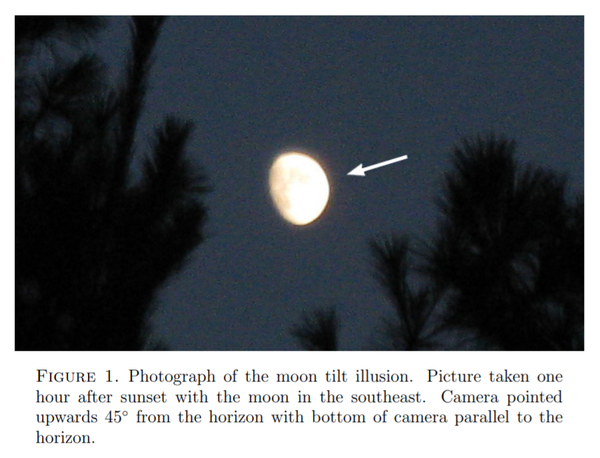
(Source)
Professor Myers at the University of Pennsylvania provides the following description:
http://www.upenn.edu/emeritus/essays/MyersMoon.html (Archive)
“ One evening several years ago, I took this picture of the misty glow of an almost full moon shining between pine trees in my backyard. The moon was beautifully illuminated and dominated the dark sky. Yet something was disturbing about the atmospheric night scene: the illumination of the moon seemed to be coming from the wrong direction! In this photograph of a waxing moon in the southern sky, its illumination appears to be coming from above to the right. But the sun---which had set an hour earlier---was already below the western horizon to the right when this photo was taken. If the sun is below the horizon, I thought, shouldn't its illumination of the moon appear to be coming from below the horizon? Intrigued, I made further observations when both the sun and the moon occupied the evening sky at the same time, and it certainly seemed that light rays from the sun would have to follow a curved path to shine on the moon at the observed angle. The sketch drawn below may help to explain the difference between what I expected to see and what I actually saw.
I asked everyone willing to listen if they were familiar with this illusion: why does a light ray from the sun to the moon appear to follow a curved path? No one had seen or heard of it. Several imaginative explanations were offered: "The light rays are bent by the earth's atmosphere." Or, "Gravitational lensing as predicted by Einstein's general theory of relativity is responsible." I was surprised not to find the illusion described in astronomy textbooks. I googled "moon illusion" but the articles were about an entirely different illusion: the apparent magnification of the full moon when it's close to the horizon.
Finally, help came from my daughter, who located published papers by googling "moon tilt illusion". The scientific explanation is based on the projection of a straight line onto the surface of a sphere. A simpler explanation was provided in a conversation with Benjamin Shen, Professor Emeritus of Astronomy at Penn, who said that light appears to follow a great circle route from the sun to the moon. That's why the moon's lit face appears to us not to face the sun squarely, regardless of whether the sun is above or below the horizon.
The moon tilt illusion is counter-intuitive and magical---look for it the next time you are under a night sky. ”
Moon Tilt Observational Diagram
In a related paper from the same author titled The Moon Tilt Illusion (Archive), Professor Myers provides the following diagram of the observed tilt of the Moon and its displacement from the expected angle:
At times the Moon is pointing towards the Sun, and at other times the Moon is pointing away from it. When opposite from the Sun, the Moon tilt can be wildly displaced from its expected position.
Sun and Moon Anomaly
From a Stack Exchange post on the Moon Tilt Illusion we read:
“ Below is a photo that my son took in Scotland showing the sun and moon at the same time. I immediately noticed this anomaly that the light illuminating the moon could not possibly come from the sun. I sent the photo to 4 University astronomy departments and only one responded and that was Cambridge University which is near where I live. The response came from the department librarian (not an astronomer) who said he had never heard of this before. He gave me two possible solutions, one was was from an engineer (not an astronomer) in which he got confused between perspective and light ray tracing and the other was referring to Einstein's theory of light bending by gravity. I check out Einstein and the effect was so small as to be almost immeasurable. ”
“ I have looked at the various 'complex' explanations for what to me is a very simple model. What need is there to introduce 'curved planes' and 'starry sky domes' all of which do not exist in reality? It is only referred to as an 'illusion' because observation doesn't fit the conventional model hence the complex explanations to try and make it work. The anomaly is acknowledged to exist with or without photos. Since everyone believes that the moon is illuminated by the sun then simple normal physics do not seem to work. Either the physics is wrong or the sun does not illuminate the moon. I realise that is a heavy statement!
Therefore I state once again:
- The sun and the moon are two objects (like a torch and a football) that are suspended in a 3 dimensional space and size should not matter.
- The moon/football are illuminated by the sun/torch and a perpendicular line or light ray can be drawn between them.
- It doesn't matter where in space you choose to view them, a perpendicular line or light ray can still be drawn between them.
This drawing explains my doubts: ”
“ I'm very surprised that some of you have never noticed it before hence the suggestion asking me to post a video. This is a very common occurrence and I have seen it many many times as I go for my morning walk at about 8.00am every morning. I have never thought of actually tabulating my observations. ”
A Different Moon Illusion
Another observation is given here:
http://www.astropix.com/html/l_story/moonill.html (Archive)
“ Now, I have always under the impression that if you took the Moon's phase illumination angle it would draw a line straight back to the sun. But this sure wasn't what I thought I saw this day.
Obviously, it's an illusion that has something to do with a three-dimensional space being projected onto a two-dimensional plane in my eyeballs. Some people have tried to explain it as involving great circles, just as airplanes fly great circle routes to places on the opposite side of the globe. However they only do this because they can't fly a straight line through the Earth.
What I can't seem to get past is that the Sun and the Moon were in the same field together and I could view them both at the same time and that the light from the Sun is going in a straight line from the Sun to the Moon. It is not following a great circle. ”
Explanations
Perspective Explanations
An explanation of the Moon Tilt Illusion is given in the form of a perspective effect. It is possible to get very close to an object and make it appear to change angle and point upwards, downwards, or to the side. It is claimed that this is occurring with the Moon.
A VSauce video titled The Moon Terminator Illusion (Runtime:11m) explains the Moon Tilt Illusion via a perspective effect:
In the above demonstration VSauce references a close range perspective effect. However, that same effect is not going to occur with the same motions of the camera if the screen is far from the observer. The camera would need to move of equal proportions if the laptop screen is far away. Under the Sun-Earth-Moon system the bodies maintain the same distances from the observer at all times, and do not move closer or further from the observer enough, as compared to their distances, as to cause a large perspective effect changes.
Another version of the perspective argument is given here:
The Moon is pointing downward at the Sun at the horizon. Moving the camera close to the Moon, the Moon appears to point upwards.
In contrast to this argument, under the Round Earth Theory both the Sun and the Moon are far away from the observer and are at the same distance from the observer at all times. They do not change distances radically from the observer, as the camera changes in relation to the Moon in the above animation. As an example; a pencil 10,000 feet away from the observer will not be subject to close range perspective as easily as a pencil held an arms length away. Hence, the explanations are extraneous to the systems in the Round Earth Theory.
Difference in Position Diagram
According to the RET over the course of a day the changing of distance to the Moon is negligible. The Moon maintains its distance from the center of the Earth at all times slowly rotating around it. The Earth in turn rotates at a faster rate in relation to the Moon. An observer on the surface of the Earth at either side of the Equator will observe a change in the position of the Moon by less than 2 degrees due to positional changes alone, as demonstrated in the below illustration:
In the above diagram the outer orange circle is the distance between the Earth to the Moon turned into a circle. Divided by 360 degrees gives the number of degrees per mile, which is used to find the displacement in degrees between the extremes of either side of the Earth.
Looking at the Sun as compared to the Earth's Diameter or the Moon's Orbit Diameter with a similar methodology we also find negligible differences in angle displacement:
- Earth Diameter: 7917.5 mi
- Diameter of Moon Orbit: (Dist to Moon) 238,900 x 2 = 477,800 mi
- Distance from Earth to Sun: 92,900,000 mi
- Circumference of Earth to Sun Radius: 2 * pi * 92,900,000 = 583,707,915.037
- 583,707,915.037 / 360 = 1621410.8751 mi per degree
- (Moon Orbit Diameter) 477,800 mi / 1621410.8751 = 0.29468 Degrees Max
- (Earth Diameter) 7917.5 / 1621410.8751 = 0.00488 Degrees Max
One must wonder where all of the perspective changes for the Moon Tilt Illusion are coming from. It is certainly not from the geometry of the Sun-Earth-Moon system.
The argument that perspective can cause drastic changes to the positioning of the Moon is hence questionable. The examples given with toys at close range are of little relation to the systems proposed by astronomy. A geometric explanation applicable to such a scheme is unavailable.
Hallway Perspective
Another perspective example is given in the way of standing in the middle of a hallway. In The Moon Tilt Illusion (Archive) we read a description:
The above scenario involves standing in the middle of a long hallway, and observing that the ceiling above you is horizontally parallel and that the the angles of the ceiling at either end are tilted to perspective. The movement of the Moon is just like traveling down or up the length of the ceiling of a hallway, and will change to perspective like the angled corners of the ceiling at either ends. At one end of the hallway the Moon is angled upwards in one direction, when it is over you it will be horizontal, and then when it is down on the other end it will be angled downwards.
However, example involves a celestial body that is close to the earth, radically changing distance to the observer in relation to their distance above the Earth. Under the Round Earth model the Sun and Moon are essentially the same distance from the observer at all times, and so will not change much to perspective. In contrast to RET, the edges of the hallway ceiling in the example are not the same distance from the observer at all points. The points along the edge of the hallway ceiling change in distance to the observer. We see again that the argument made is specious and unrelated to what is claimed by the Round Earth Theory's astronomical model.
Ball Experiment
Another attempt at showing that the matter may be caused by perspective takes the form of a ball experiment performed with the Moon in the background. Since it is possible to use a close range perspective effect with a ball in the near field to get it to point in a variety of different directions, it is concluded that this what must be happening with the Moon.
In a MetaBunk thread Mick West views a Moon Tilt Illusion and performs the following: (Archive)
Mr. West angles the camera close and right up to the ball to get it to point away from the Sun like the Moon does:
The author uses a close-range perspective effect to match the Moon. There is little doubt that holding something very near to one's face can create lots of angles. The fallacy in this is that under RET the Moon is not a small ball very close to the observer. The Moon is far from the observer and maintains its distance from the Sun at all times. The Moon does not radically change its distance from the observer. Perspective affects orientation less and less with greater distances.
We again see repetitions of the fallacies above, and a failure to provide a geometric explanation for the Moon Tilt Illusion.
Celestial Sphere
Another explanation for the Moon Tilt Illusion involves a "Celestial Sphere" in the sky, upon which straight lines become curved.
In the paper The Moon Tilt Illusion (Archive) by Adrea and Alan Myers, the following is stated:
“ The moon tilt illusion is not described in astronomy textbooks because astronomers know that straight lines in object space become great circles on the celestial sphere. Minnaert [5] gives only a passing reference: “...the line connecting the horns of the moon, between its first quarter and full moon, for instance, does not appear to be at all perpendicular to the direction from sun to moon; we apparently think of this direction as being a curved line. Fix this direction by stretching a piece of string taut in front of your eye; however unlikely it may have seemed to you at first you will now perceive that the condition of perpendicularity is satisfied”. An article by Sch¨olkopf [8] documents the illusion in an experiment involving 14 subjects by having them indicate their expectation of how the moon’s illumination should be oriented with respect to the position of the (visible) sun. He reports that an average discrepancy of 12◦ is perceived by the subjects between the observable versus expected orientation of the moon’s bright limb. Schott’s website entitled “ ‘Falsche’ Mondneigung” (‘False’ Moontilt) [9] is devoted to the moon tilt illusion, and features illustrations and useful links. Schott correctly proposes to quantify the effect by comparing the observed tilt angle with the angle from horizontal of the line connecting the moon and sun, but an error in geometry leads to an incorrect expression for the expected tilt. A paper by Glaeser and Schott [2], approaching the phenomenon via the principles of photography, show that the magnitude of the illusion could in theory be measured through comparison of a close-up shot of the moon with a photograph containing both sun and moon, with the camera directed in a specified direction between them (although no equations are given). However, as they point out, in practice it is not feasible since even a wide-angle lens cannot capture both sun and moon in a photo with azimuth differences for which the illusion can be most clearly observed (between 90◦ and 180◦). Berry[1] proposed using a star chart, which is a zenith-center stereoscopic projection of the celestial sphere onto a flat surface, to define the moon tilt illusion as the angle between the projected great circle and a straight moon-sun line drawn on the same chart “mimicking how we might see the sky when lying on our back looking up”. Clearly, there exists a lack of consensus in the literature about the explanation of the moon tilt illusion and disagreement about the best way to describe it.
...Astronomers rely upon the celestial sphere model for maps of the sky because locations of stars and constellations depend only on their right ascension and declination. For the topocentric model used for the sun and the moon, location is specified by azimuth and altitude. All objects in the sky are assumed to be located at the same distance from the observer, as if pasted upon the surface of an imaginery sphere surrounding the observer. Astronomers, for whom the celestial sphere model is a basic tool for mapping the stars, are not surprised by the apparently curved path of light from the sun to the moon because they know that straight lines in 3-D object space are transformed to great-circle arcs on the imaginary celestial sphere. ”
We are told that straight lines become curved when looking into the sky because of the "celestial sphere" which exists above our heads.
A demonstration against this concept may be found in any 3D modeling program. Create a long straight line and place the camera at various distances from it. At what point does the straight line become curved? The answer we have found is: At no point. A straight line in the distance will always be straight. If the line were a green arrow pointing at an orange ball, the green arrow would always point at the orange ball.
On this topic we receive arguments such as "what you're failing to consider is that the night sky is not a euclidean space; it's a curved surface." But just what is being described? In RET the sky isn't a "curved surface". It's not a surface at all. What reason is there to think that we would see it as a surface around us? This can only be seen as wild imagination from a desperate position.
Hence, the concept of a celestial sphere is seen to be a contrived concept bearing no relation to the 3D space which the Sun-Earth-Moon systems of astronomy are said to exist in. As there is no sphere around the Earth in RET upon which straight lines may become curved, it is again found that a geometric explanation for the Moon Tilt Illusion is unavailable. Astronomers disagree among themselves on the cause, with some speculating on a planetarium-like celestial sphere which does not exist in the physical Sun-Earth-Moon system.
Celestial Sphere Project
We are given a Moon Tilt Illusion scene cut into a 'Celestial Sphere' to give a better idea on "how things work in 3D space." Straight lines become curved on the celestial sphere.
Unfortunately, this example comes with a fictitious premise. The sky is not a sphere which the sun and moon and lines of light rays rest against to cause artificial curvature. Straight lines will be straight in the sky above us, not 'curved on a celestial sphere'.
If the Sun and Moon can be connected in such a manner, it merely provides a small clue for the underlying mechanism, and does not imply that there is a "celestial sphere" above the Earth where "straight lines become curved". Such a mechanism is entirely unexplained and nonphysical in the Round Earth Theory.
Equation of Prediction
In The Moon Tilt Illusion (Archive) Professor Myers provides an equation used to predict the

